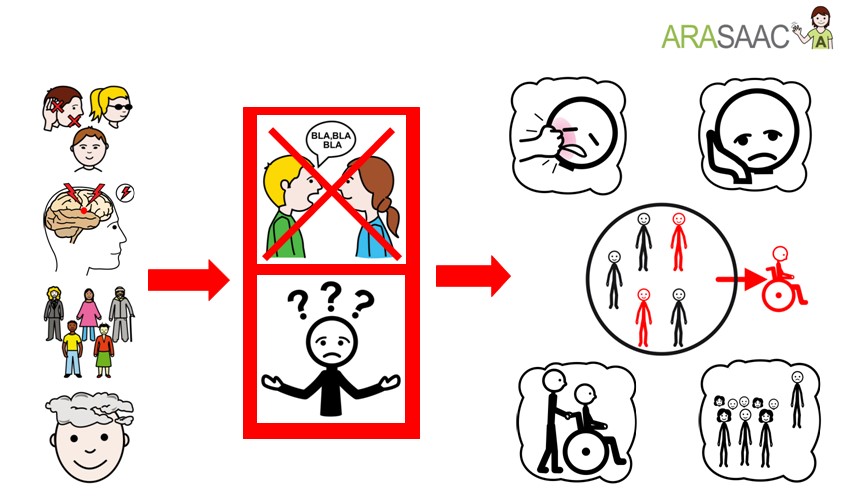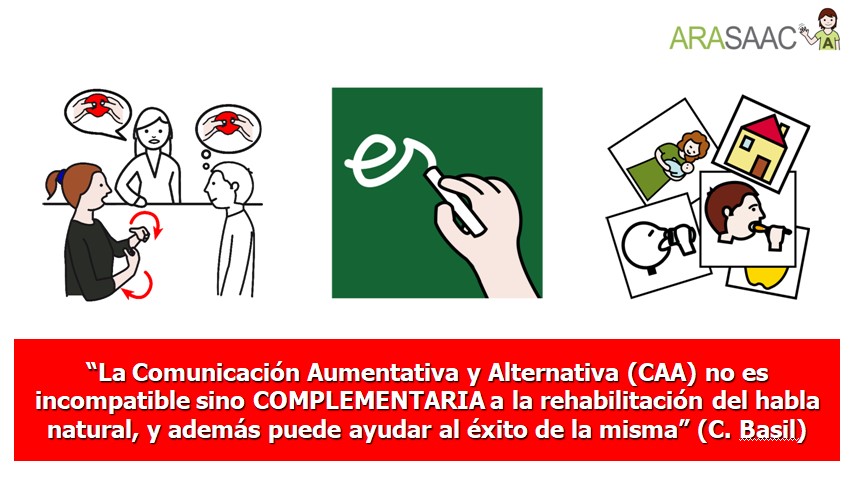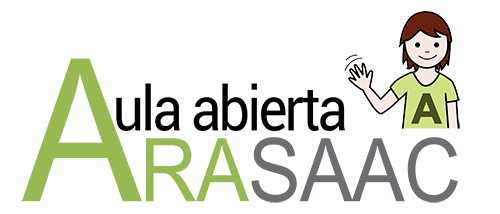 This work is licensed under a Creative Commons Attribution-NonCoercial-ShareAlike 4.0 International license.
This work is licensed under a Creative Commons Attribution-NonCoercial-ShareAlike 4.0 International license.
Our thanks to BJAdaptacionesfor allowing us to base this page and copy some full texts from their blog article Myths and Realities about Early Intervention in Augmentative Communication.”
Some families and professionals, erroneously, consider that the use of Augmentative and Alternative Communication (AAC) is the last resort that should be used with non-verbal people and that we should only go to it when speech does not appear.
We must not forget that communication and language are essential for the human being and help us to express our needs and desires, interact with the immediate environment, relate to other people and enjoy free time.
Barriers in communication,due to absence or lack of intelligibility, cause, in most cases, the appearance of disruptive behaviors (aggressiveness, isolation, dependence on third parties, loss of self-esteem, etc.) that hinder inclusion in any area of daily life.

Professionals of great prestige in this field and who have worked for many years in practice, such as Carmen Basil,affirm that “Augmentative and Alternative Communication is not incompatible but COMPLEMENTARY to the rehabilitation of natural speech,and can also help the success of it. It should therefore not hesitate to introduce it at an early age, as soon as difficulties in the development of oral language are observed, or shortly after any accident or disease has caused its deterioration. There is no evidence that the use of AAC inhibits or interferes with speech development or recovery.”

In 2005, MaryAnn Romski and Rose Sevcik conducted research on more than 60 publications on the practical use of AAC in which, after a detailed analysis, they refute all the false myths on this subject. This research results in the following article that we should keep in mind when evaluating and implementing a communication system and eliminating false beliefs: “Augmentative Communication and Early Intervention. Myths and Realities“.
Next, we copy and paste this comprehensive summary extracted from the BJAdaptaciones blog entitled “Myths and realities about early intervention in augmentative communication” in which a detailed compendium of the myths and realities about this research is made.
 “What are the myths of Augmentative and Alternative Communication (AAC)?
“What are the myths of Augmentative and Alternative Communication (AAC)?
- AAC is the last resort in speech and language therapy.
- AAC hinders or slows the onset of speech.
- Children must have prior skills in order to benefit from AAC.
- Devices with voice output are only for children without cognitive difficulties.
- It is necessary to be a minimum of age to be able to benefit from the CAA.
- There is a representational hierarchy of symbols, from objects to the written word.
 What are the realities of Augmentative and Alternative Communication (AAC)?
What are the realities of Augmentative and Alternative Communication (AAC)?
- It is never too early to introduce AAC,as the tools and strategies employed should be taken as a means, not an end. The CAA provides a firm foundation for spoken language development, language comprehension, and production.
- AAC not only does not stop the appearance of speech, but in some cases even facilitates it. A clear example is that of children who use gestural signs to begin to communicate, and that when the appearance of speech begins, they stop using the signs. The child who is able to communicate, using whatever means, is more likely to participate more actively in society.
- Children who do not use an AAC, although they do not have oral language, are excluded from certain educational levels,or intervention programs, because it is assumed that they do not have the appropriate cognitive skills, without having made an exhaustive evaluation, and without offering the necessary Communication tools. A clear example is children with serious motor difficulties, whose cognitive ability has not been demonstrated.
- A few years ago, the cost of AAC devices was one of the reasons why their use was ruled out. The other reason was because the devices that existed on the market required certain cognitive skills to be used. Now, they are much more affordable and easy to use for the user. Devices are a tool even when you start using AAC, and should never be considered an end. Having a “voice” at an early age can facilitate one’s identity,in addition to communication.”
Communication and cognitive accessibility are two very serious issues that affect many people, so we should not be guided by myths or personal opinions. As you have seen in this research, AAC is a delicate and vital issue for many people, which requires a multiprofessional approach, in close collaboration with the family, to establish what should be the most appropriate communication system for each person, taking into account their characteristics, abilities and learning style.
Finally, we must bear in mind Article 24-1 of the Convention on the Rights of Persons with Disabilities, which states:
“States Parties shall provide persons with disabilities with the opportunity to learn life skills and social development in order to promote their full and equal participation in education and as members of the community. To this end, the States Parties shall adopt the relevant measures, including:
a) Facilitate the learning of Braille, alternative writing, other modes, augmentative or alternative means and formats of communication and orientation and mobility skills, as well as mentoring and peer support”
Let us continue to work along these lines.
Biliography and links
- “Augmentative Communication and Early Intervention. Myths and Realities“, Romski, M.A., Sevcik, Rose A. (2005) – Infants & Young Children Vol. 18, No. 3, pp. 174–185. Lippincott Williams & Wilkins, Inc. Electronic edition
- Pressman Companion Article, H: “False Beliefs, Widely Held: The Myths Professionals Perpetuate and the Harm They Cause in Young Children with Disabilities.” Electronic edition
- “What is AAC?”, Basil C.,in “Aula Abierta de ARASAAC.










